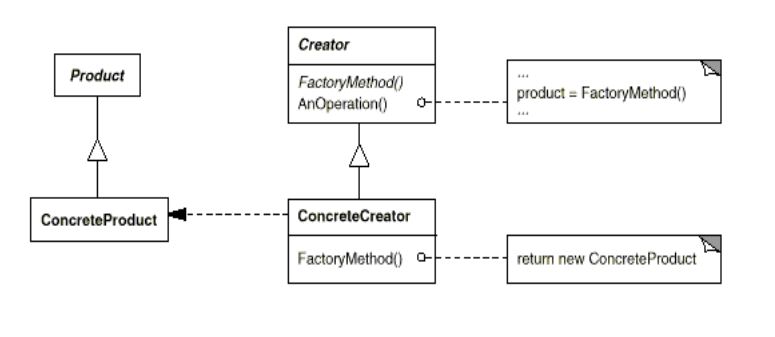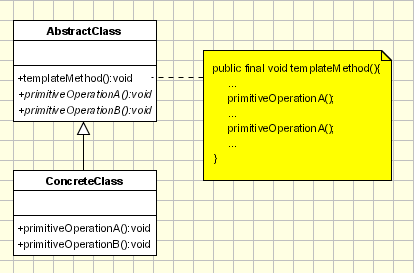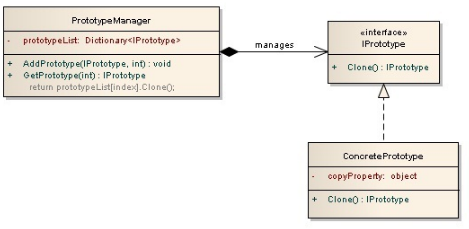CSC/ECE 517 Fall 2012/ch2b 2w36 av: Difference between revisions
No edit summary |
No edit summary |
||
| Line 152: | Line 152: | ||
'''Sheep.java''' | '''Sheep.java''' | ||
The Sheep object is a concrete prototype that extends the Animal prototype. The Sheep prototype has a clone method to clone itself to create a new object. | The Sheep object is a concrete prototype that extends the Animal prototype. The Sheep prototype has a clone method to clone itself to create a new object. | ||
| Line 159: | Line 160: | ||
'''Chicken.java''' | '''Chicken.java''' | ||
The Chicken object is a concrete prototype that extends the Animal prototype. The Chicken prototype has a clone method to clone itself to create a new object. | The Chicken object is a concrete prototype that extends the Animal prototype. The Chicken prototype has a clone method to clone itself to create a new object. | ||
| Line 166: | Line 168: | ||
'''AnimalCreator.java''' | '''AnimalCreator.java''' | ||
The AnimalCreator class is used to create and manage prototype objects. The AnimalCreator class contains two concrete prototypes that are initialized during the initialization of the class. The AnimalCreator class forms part of the "Prototype" pattern by returning a cloned object (Animal) to the client without the client knowing the type of the prototype. | The AnimalCreator class is used to create and manage prototype objects. The AnimalCreator class contains two concrete prototypes that are initialized during the initialization of the class. The AnimalCreator class forms part of the "Prototype" pattern by returning a cloned object (Animal) to the client without the client knowing the type of the prototype. | ||
| Line 181: | Line 184: | ||
AnimalClient.java | '''AnimalClient.java''' | ||
The AnimalClient class makes use of the AnimalCreator class to create a concrete prototypes of typeAnimal. The AnimalClient class does not know the type of the concrete prototypes but references them through the Animal prototype. | The AnimalClient class makes use of the AnimalCreator class to create a concrete prototypes of typeAnimal. The AnimalClient class does not know the type of the concrete prototypes but references them through the Animal prototype. | ||
Code: | Code: | ||
[13] | AnimalCreator animalCreator = new AnimalCreator(); | ||
Animal[] animalFarm = new Animal[8]; | |||
animalFarm[0] = animalCreator.retrieveAnimal("Chicken"); | |||
animalFarm[1] = animalCreator.retrieveAnimal("Chicken"); | |||
animalFarm[2] = animalCreator.retrieveAnimal("Chicken"); | |||
animalFarm[3] = animalCreator.retrieveAnimal("Chicken"); | |||
animalFarm[4] = animalCreator.retrieveAnimal("Sheep"); | |||
animalFarm[5] = animalCreator.retrieveAnimal("Sheep"); | |||
animalFarm[6] = animalCreator.retrieveAnimal("Sheep"); | |||
animalFarm[7] = animalCreator.retrieveAnimal("Sheep"); | |||
for (int i= 0; i<=7; i++) { | |||
System.out.println(animalFarm[i].helloAnimal()); | |||
} // for [13] | |||
Revision as of 23:39, 16 November 2012
Factory Method pattern and the related patterns (Template, Prototype)
Factory Method
Factory method pattern is an Object Oriented Programming concept in which objects can be created without specifying the class to which they belong.Factory method pattern implement the concept of using an object to generate other objects.<ref name="web">http://www.oodesign.com/factory-pattern.html
</ref>Factory method is thus a type of creational pattern. An interface is defined for object creation. However the subclasses decide which class they want to instantiate. Factory methods thus abstract object instantiation from the client.<ref name="userpagesfactory">http://userpages.umbc.edu/~tarr/dp/lectures/Factory.pdf
</ref>
The new operator is used in languages like Java to create an object. However in this case the object creation details are not encapsulated. Factory method allows a client to request for an object so that the object creation is encapsulated. Factory method uses inheritance for object creation. The superclass has ‘placeholders’ for the steps involved in object creation. The actual details of the object creation are specified in the subclass.<ref name="sourcemakingfact">http://sourcemaking.com/design_patterns/factory_method
</ref>
Use of factory method pattern makes the code more flexible to change. In factory method pattern, interface is used to create an object and the actual instantiation of objects is deferred to subclasses that implement this interface. New classes can be added that implement this interface. In this way it becomes easy to add new concrete classes with minimal changes to the classes that use these objects.[head_first_design_pattern]. Factory method can be used when a class does not know the type of objects that it needs to create. <ref name="userpagesfactory" />
UML Diagram for Factory Method Pattern

In the UML diagram on the right, Product is the interface for the type of object created by the factory method. The Product interface is implemented by ConcreteProduct. The factory method which returns an object of type Product, is declared in Creator. The factory method is overridden inside ConcreteCreator to return an instance of ConcreteProduct.
Code Example
This example has been taken from <ref name="sourcemakingfact" />
public interface ImageReader {
public DecodedImage getDecodedImage();
}
public class GifReader implements ImageReader {
public GifReader( InputStream in ) {
// check that it's a gif, throw exception if it's not, then if it is decode it.
}
public DecodedImage getDecodedImage() {
return decodedImage;
}
}
public class JpegReader implements ImageReader {
//...
}
In the example above the ImageReader interface is defined. In this interface, a method getDecodedImage is defined that should return a decoded image. However this image may have been encoded in any format for example GIFF or JPEG. Therefore the functionality of actually decoding the image is implemented inside two classes GifReader and JpegReader . In this way, the responsibility of creating objects decoded in the appropriate format has been delegated to the subclass implementing the interface.
Template Pattern
Template method pattern is used to specify the format of an algorithm. The basic skeleton of an algorithm is defined in the base class using abstract operations. Subclasses override these abstract operations in order to provide concrete behaviour. In this way, two different subclasses may have different implementations of the abstract functions, but the overall structure of the algorithm will remain same.<ref name="ootemplate">http://www.oodesign.com/template-method-pattern.html
</ref>Template method pattern is a behavioural design pattern.<ref name="wikitemplate">http://en.wikipedia.org/wiki/Template_method_pattern
</ref> Template method pattern helps to avoid code duplication and aids in code reuse.<ref name="userpagestemp">http://userpages.umbc.edu/~tarr/dp/lectures/Template.pdf
</ref>
UML Diagram for Template Method Pattern

In the UML diagram on the right, abstract primitive operations are defined for which the subclasses provide the implementation. Template method is implemented which specifies the structure of the algorithm. The primitive operations are called within this template method. The ConcreteClass provides subclass specific implementation for the primitive operations.
Code Example
This example has been taken from <ref name="userpagestemp" />
public abstract class TextDocument {
public final void printPage () {
Document document = createDocument();
document.printTextHeader();
System.out.println(document.body());
document.printTextFooter();
}
public abstract Document createDocument();
public abstract void printTextHeader();
public abstract void printTextFooter();
...
}
public class PlainTextDocumentBuilder extends TextDocument {
public PlainTextDocumentBuilder(InputStream in){
//check that it is an Plain text document or throw error
}
public Document createDocument()
{
return new PlainTextDocument();
}
public void printTextHeader () {
// Code for header plain text header here.
}
public void printTextFooter () {
// Code for header plain text footer here.
}
...
}
public class HtmlTextDocumentBuilder extends TextDocument {
public HtmlTextDocumentBuilder(InputStream in){
//check that it is an HTML text document or throw error
}
public Document createDocument()
{
return new HtmlTextDocument();
}
public void printTextHeader () {
// Code for header HTML text header here.
}
public void printTextFooter () {
// Code for header HTML text footer here.
}
...
}
In the above example, two types of text documents are processed, plain text Document and HTML text document. To print any of the document, the procedure to print the document body is the same. However the methods to print the header and the footer are different for both the documents. Therefore they are defined in the abstract class but the specialized implementation is provided in the subclass. printPage() is the template method. Two types of objects are used, PlainTextDocument and HtmlTextDocument. A Factory method createDocument() is called within the Template method printPage() for this purpose.
Prototype Design Pattern
The Prototype pattern creates a new object by cloning an existing object. The client using the prototype object does not need to know what kind of object it deals with as long as the concrete prototype extends or implements the prototype interface or class. The concrete prototype object is responsible for cloning itself and hence returning the cloned object. The pattern thus enables a client to create the kind of object required at runtime by selecting the appropriate prototype. The prototype classes are created generically by the client without the client knowing the exact type of the concrete prototype. New concrete prototypes can be added at run-time as long as they are similar to the abstract prototype [11]. This pattern allows you to avoid expensive initialization routines when you construct objects that are very similar. Also the goal is to minimize the amount of work needed in creating new objects when the initialization routines are expensive. For example, if the initialization routine requires database queries, file look ups, or service calls and you already have other objects in the system that are very similar to the object you are constructing, then the prototype pattern comes into picture and helps you avoid those expensive initializations.
We have a look at the UML diagram for the prototype design pattern:

From the above diagram we can decipher the following things that are: PrototypeManager class is just a manager class that is used to add and retrieve prototypes by an index number; it has the following variable and methods:
• prototypeList variable: It is the collection that stores all the prototypes
• AddPrototype method: Allows you to add a prototype to the collection and assigning it an index number
• GetPrototype method: Allows you to retrieve a prototype from the collection using an index number
The IPrototype interface specifies the methods that all prototype classes must implement. It has the Clone method that returns an IPrototype interface.
The ConcretePrototype class is the actual prototype class; it implements the IPrototype interface and has the following property and method:
• copyProperty variable holds the information that is prepopulated. If the variable value is changed then the new instances created will have the new value.
• Clone method will make a copy of itself and return it. If the copyProperty is a value type (such as int or string) then we can use shallow copy. If the copyProperty is a reference type (such as an object that contains other objects) then we go for deep copy of the variable.
The key to this pattern is that you will create your first object with the expensive initializations, and then store the values as a prototype in the repository. When you need create the same object again you can just get the copy of the prototype from the repository with all the values already populated. This reduces the performance overhead [12].
Java Sample code to show prototype design pattern
The following is an example of the Prototype Pattern. The prototype object is an Animal object. The Animal prototype contains two concrete prototype subclasses namely Sheep and Chicken. TheAnimalCreator class contains references to the two concrete prototypes. During the initialization of theAnimalCreator class the two concrete prototypes, Sheep and Chicken are created and stored as the two concrete prototypes members of the AnimalCreator class. The AnimalCreator class contains a retrieveAnimal method that clones a prototype Animal depending on the parameter that is passed to it.
Animal.java
The Animal class is the abstract prototype of the two concrete prototypes in the example. The client invokes methods on the two different concrete prototypes through the Animal type to ensure the client does not know the type of the concrete prototypes. Most importantly, the Animal prototype defines a clone method to assist the two subtypes or concrete prototypes to clone themselves.
Code:
public Animal clone() {
Animal clonedAnimal = null;
try {
clonedAnimal = (Animal) super.clone();
clonedAnimal.setDescription(description);
clonedAnimal.setNumberOfLegs(numberOfLegs);
clonedAnimal.setName(name);
} catch (CloneNotSupportedException e) {
e.printStackTrace();
} // catch
return clonedAnimal;
} // method clone
Sheep.java
The Sheep object is a concrete prototype that extends the Animal prototype. The Sheep prototype has a clone method to clone itself to create a new object.
Code:
public class Sheep extends Animal {
Chicken.java
The Chicken object is a concrete prototype that extends the Animal prototype. The Chicken prototype has a clone method to clone itself to create a new object.
Code:
public class Chicken extends Animal {
AnimalCreator.java
The AnimalCreator class is used to create and manage prototype objects. The AnimalCreator class contains two concrete prototypes that are initialized during the initialization of the class. The AnimalCreator class forms part of the "Prototype" pattern by returning a cloned object (Animal) to the client without the client knowing the type of the prototype.
Code:
public Animal retrieveAnimal(String kindOfAnimal) {
if ("Chicken".equals(kindOfAnimal)) {
return (Animal) chicken.clone();
} else if ("Sheep".equals(kindOfAnimal)) {
return (Animal) sheep.clone();
} // if
return null;
} // method retrieveAnimal
AnimalClient.java
The AnimalClient class makes use of the AnimalCreator class to create a concrete prototypes of typeAnimal. The AnimalClient class does not know the type of the concrete prototypes but references them through the Animal prototype.
Code:
AnimalCreator animalCreator = new AnimalCreator();
Animal[] animalFarm = new Animal[8];
animalFarm[0] = animalCreator.retrieveAnimal("Chicken");
animalFarm[1] = animalCreator.retrieveAnimal("Chicken");
animalFarm[2] = animalCreator.retrieveAnimal("Chicken");
animalFarm[3] = animalCreator.retrieveAnimal("Chicken");
animalFarm[4] = animalCreator.retrieveAnimal("Sheep");
animalFarm[5] = animalCreator.retrieveAnimal("Sheep");
animalFarm[6] = animalCreator.retrieveAnimal("Sheep");
animalFarm[7] = animalCreator.retrieveAnimal("Sheep");
for (int i= 0; i<=7; i++) {
System.out.println(animalFarm[i].helloAnimal());
} // for [13]
References
<references />